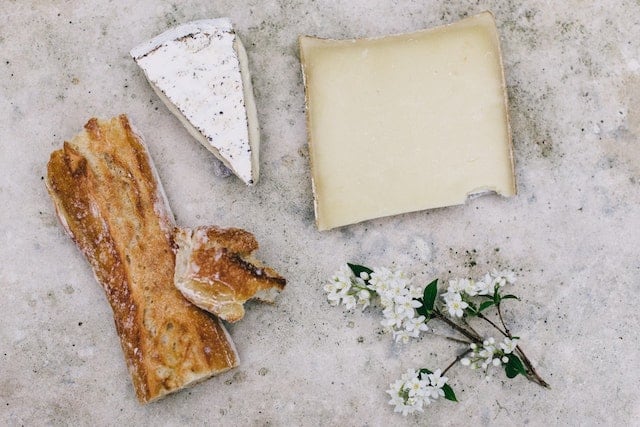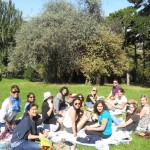Falling for the Delicious Intricacies of French Food Culture

When people ask me why I love France, I always quote my French host mother.
“When French people sit down to eat, they immediately begin talking about their next meal.”
Her statement is a bit of an exaggeration, but it illustrates what I love most about the French people: their immense love for food.
When I first visited Paris in June 2011, I drank wine in the shadow of Notre Dame, experienced steak tartare for the first time and scarfed down Nutella crepes on a warm summer night. I left Paris with stars in my eyes, in love with the people, places and foods that France had to offer. But it wasn’t until I returned to spend a semester in Paris in fall 2013 that I began to appreciate the nuances of French food culture.
“When French people sit down to eat, they immediately begin talking about their next meal.”
On the day before I moved in with my Parisian host family, the leaders of my study abroad program explained French table manners to us.
“In French homes, there is no such thing as a bread plate,” our lecturer began, going on to explain that bread should be placed directly on the table. Furthermore, you should always tear off pieces of bread, as opposed to biting into a slice like a savage. These bits of bread etiquette were just the beginning of the idiosyncrasies I experienced while living and studying in France that semester.
My French host mother, who I called “Madame,” was a small white-haired woman with a downturned mouth. She took great care with her appearance each day, tucking her short hair into a jewel-colored scarf before setting out to buy groceries. In fact, she was equally meticulous when it came to her olive- and coral-colored apartment. She had strict, strange rules which put me on edge; I was often afraid that I would upset her by forgetting to close the blinds or putting my dishes away in the wrong cabinet. However, my Madame and I quickly found something to bond over: a fondness for food.
Four nights a week, I ate three-course meals prepared by my Madame. While my Madame told me about her day in French, I enjoyed the food she had prepared: thin slices of chewy bakery bread, lamb’s lettuce dripping with mustard vinaigrette and delicate fish quenelles (dumplings) smothered in cream sauce. Dessert, my least favorite part of the meal, was often a few spoonfuls of fromage blanc topped with a dollop of rhubarb jam.
Between mouthfuls of food, my Madame relayed random facts about French food to me.
My Madame loved the way I gobbled up her food, but my big appetite had a downside: she could always tell when I didn’t like something because I didn’t take seconds. I struggled to swallow even one serving of slimy, cold cooked leeks in mayonnaise vinaigrette; I simply couldn’t eat another helping.Every other night, she quizzed me on the ingredients in each dish. When I ventured a guess, she would press me.
“What else? What else do you taste?” she asked, her face coloring with disappointment when I guessed incorrectly. My limited French food vocabulary only hindered me in this little game.
My homestay was far from ideal, but I learned a lot from my Madame about how the French relate to food. When I returned to Paris this year to study cooking at the famous Le Cordon Bleu, I realized how much more there was to learn.
My Madame served me the traditional food that she grew up eating. She scoffed at American influences on French culture and introduced me to her generation’s views on food in France.
My Madame loved the way I gobbled up her food, but my big appetite had a downside: she could always tell when I didn’t like something because I didn’t take seconds.
Returning to Paris to study at Le Cordon Bleu has introduced me to two more perspectives on French gastronomy. At Le Cordon Bleu, much of what we study is traditional French cuisine. We begin our education by cooking beef burgundy, blanquette de veau (white veal stew) and other very old, very classic French dishes. We learn how to turn vegetables and which garnishes go with which dishes. Many of the recipes we use are based on those conceived by Escoffier during the late nineteenth and early twentieth centuries. All of this is fascinating to me, because that type of cooking has shaped French food and culture over the last century.
Almost more interesting, however, is what I have learned by observing French people in my daily life. These are the people that have taught me about modern French food culture. Although McDonald’s has taken hold of France and chain grocery stores like Monoprix are everywhere, I love that many French people still take the time to go to their local market, butcher or fish monger.
Falling for the Delicious Intricacies of French Food Culture.
I love that I pass four bakeries on my 15-minute walk to school and I love that every one of those bakeries offers an array of beautiful, delicious pastries better than most available in the United States. Finally, I love Parisian café culture. It’s impossible not to adore the Parisian way of life when you’re grazing on France’s finest charcuterie and cornichons while people-watching at a corner café.
When it comes to French people and food, certain things will always make me roll my eyes (albeit with fondness), like their penchant for mustard or their extreme sensitivity to all things spicy. But I have learned so much about food from the people of this country. Next time you’re in France, revel in the appreciation and love that the French have for food, as I try to do every day.
Photo credit for Falling for the Delicious Intricacies of French Food Culture by Unsplash.com.









I certainly enjoyed this article as it is well-written (as usual) and offers some wonderful, candid insight into the young woman who wrote it (more unusual). Good to know that I would eat bread correctly in France; I always tear it into pieces. When I was dating, the bread test was one I often watched for; if a young man picked up his bread and tore off a big mouthful with this teeth, I was crushed.